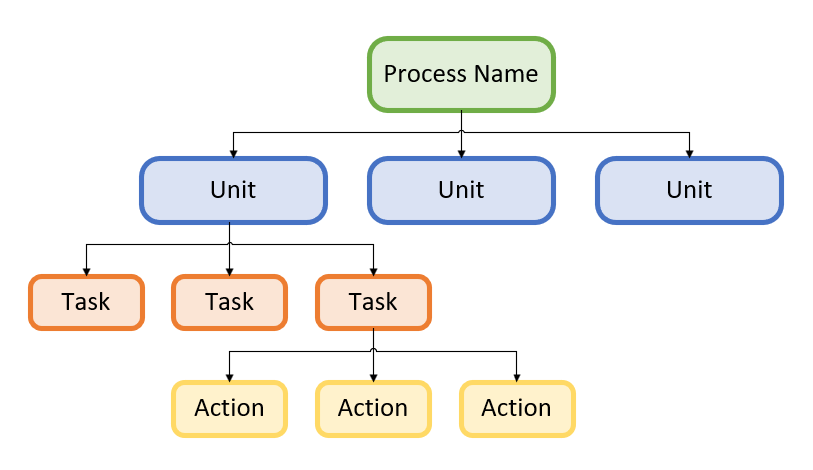Identifying process inefficiencies
Process identification is the essential first step in understanding and improving processes. It focuses on identifying how inputs are transformed into outputs. For a process to be meaningful, it must involve some form of transformation or change—without this, the process lacks purpose. This transformation must be consistent, clearly defined, and aligned with the goals of the organization or its triggers.

The process begins by breaking workflows into manageable steps, ideally no more than five, to maintain clarity and structure. Inputs, often described as verb-noun combinations (e.g., "paint fence"), lay the groundwork for identifying transformations and outputs. Unlike simple approvals or observations, process identification emphasizes the flow, order, and timing of activities, making it easier to spot inefficiencies and gaps.

A key principle of process identification is consistency. Whether you’re examining a small task or a large system, each step should align with the overall goal and follow a repeatable structure. For instance, when repainting a fence, the process might include gathering supplies, preparing the surface, applying paint, and cleaning up. These steps represent the first level of modeling in process identification, called "units." Each unit transforms the state of the fence while ensuring that no step is missed.

Process identification is also tech-neutral, meaning it can be applied across various tools or systems. While it shares similarities with context diagrams by showing inputs and outputs, it goes further by defining the flow and sequence of tasks. By focusing on triggers, artifacts (like tools or materials), and outcomes, process identification refines workflows, creates consistency, and ensures that each task contributes to meaningful transformation.
Process identification is broken down into hierarchical levels—units, tasks, and actions. Each of these levels functions as a smaller process, with inputs, transformations (formatted as "verb-noun"), and outputs. Together, these smaller processes build the entire primary process.

Units are the high-level steps within the overall process. Each unit represents a major stage or transformation in the workflow. For example, when doing laundry, the units could include sorting clothes, treating stains, loading the machine, and starting the wash cycle. At this level, the transformation focuses on the overarching activity happening in the unit without diving into specifics. Each unit involves inputs (e.g., dirty clothes or cleaning supplies), transformations (e.g., "sort clothes" or "load machine"), and outputs (e.g., sorted clothes or a loaded washing machine). Units provide a structured foundation for understanding the process at a glance.
Tasks represent the intermediate steps within a unit, breaking down how the unit's transformation is achieved. They add more detail to the process, showing the logical flow of activities required to complete the unit. For instance, in the unit "Sort clothes," the tasks might include separating clothes by colour and separating clothes by fabric. Each task also has its inputs (e.g., unsorted clothes), transformations (e.g., "separate by colour"), and outputs (e.g., piles of whites, darks, and colours). Tasks help to define the process more clearly, ensuring each unit's transformation is thoroughly addressed.

Actions are the most detailed level within the process and describe the individual, specific steps needed to complete a task. They capture the exact sequence of activities in the smallest possible steps. For example, under the task "separate clothes by colour," the actions might include dumping the clothes out and creating separate piles for whites, darks, and colours. Each action follows the same structure as units and tasks, with its inputs (e.g., a pile of mixed laundry), transformations (e.g., "create piles"), and outputs (e.g., organized piles of clothing).
Process identification is a methodical breakdown of workflows into three interconnected levels: units, tasks, and actions. Each level functions as a self-contained process, contributing to the larger workflow by ensuring clarity, precision, and consistency. This approach helps identify inefficiencies, streamline activities, and create a repeatable, effective process.
Effective process identification offers numerous advantages that can significantly enhance an organization's overall performance. One of the primary benefits is enhanced efficiency. By clearly understanding each step in a process, organizations can streamline operations, reduce waste, and improve turnaround times. This leads to smoother workflows and better utilization of resources, ultimately driving productivity and cost savings.
Another key benefit is improved quality. When processes are identified and standardized, it ensures consistency in operations. This consistency translates into higher-quality products or services, as deviations and errors are minimized. Customers and stakeholders benefit from this reliability, which can strengthen the organization’s reputation and competitive edge.
Risk mitigation is also a critical advantage of effective process identification. By recognizing potential bottlenecks or failure points within processes, organizations can proactively address these issues. This allows for better risk management and the implementation of contingency plans, reducing the likelihood of disruptions and ensuring business continuity.
Finally, effective process identification contributes to employee empowerment. Clear processes provide employees with a better understanding of their roles and responsibilities, which fosters confidence and clarity in their work. This, in turn, leads to increased job satisfaction, higher productivity, and a more engaged workforce. When employees feel empowered, they are more likely to contribute positively to the organization’s success.
Another often-overlooked benefit of effective process identification is its role in fostering innovation and adaptability. By mapping out processes, organizations can identify areas for improvement and innovation, enabling them to adapt more quickly to changing market conditions or customer needs. This agility is crucial in today’s fast-paced business environment, where staying ahead of competitors requires continuous improvement and flexibility. Additionally, a clear understanding of processes allows teams to experiment with new ideas without disrupting core operations, fostering a culture of innovation that drives long-term growth.
In summary, process identification not only enhances operational efficiency and quality but also mitigates risks, empowers employees, and promotes innovation, creating a more resilient and competitive organization.

Hi, I’m Lilly Billy, a dedicated student who’s passionate about making complex topics simple and relatable. Welcome to NotePro—a space where I share my class notes, breaking down subjects like Process identification (Identifying process inefficiencies) to into easy-to-understand insights. My goal is to offer a fresh, student-centered perspective that helps others learn effectively. Dive in, explore my notes, and let’s make learning approachable together! check out my Instagram and Facebook page for more information

